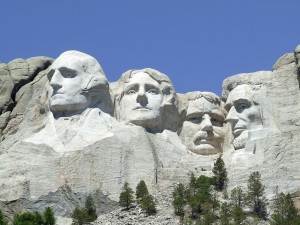Presidents’ Day is one of those holidays that I have too often let slip by without much notice, so this past week I resolved to make it a more personal experience. Given my obsessions with food, I landed on the presidential page of foodtimeline.org and quickly became entranced. Food Timeline is a dizzying array of food trivia, all compiled and maintained by a single reference librarian who, it would seem, likes to eat. Let’s go ahead and get the criticism out of the way: it is not the sexiest of websites. The whole thing is an off-putting beige color, over which is a seemingly endless scroll of text. In fact, I’m pretty sure the only target audience (other than me) is the average elementary school child saddled with an interactive social studies report. I know this because the page devoted to presidents is peppered with advice like, “Need to make something for class? How about President Taft’s beloved almond snack?” and “NOTE: boiling fat is very dangerous. Adult supervision is strongly recommended.”
Nevertheless, I find Food Timeline riveting. As might be expected given the privileged, gentlemanly upbringing of our early presidents, there are a more than a few gourmets among the bunch. Jefferson loved bringing the discoveries of his European travels home with him, making his table a cornucopia of French sauces and Dutch waffles and Italian cheeses. Chester A. Arthur brought a French chef with him to Washington. And Dolley Madison, by all accounts, could throw a seriously fab dinner party.
It isn’t that evidence of discriminating gustatory taste makes me think less of these presidents. But far more endearing, I think, are the presidential foods that are commonplace or even rather lowly. Isn’t that one of our mightiest democratic fantasies—the greatness in every man, and an everyman behind greatness? Some of these are well remembered—the Clinton proclivity for barbecue, the Nixon penchant for ketchup and cottage cheese—but others have become almost buried by the passing of time. So many presidents felt passionately about cornbread that I began to lose count. A Sunday night ritual in the FDR White House was for Eleanor to whip up scrambled eggs tableside in a chafing dish, to go with the bologna and shoestring potatoes. William Henry Harrison was unafraid to court any potential voter on the campaign trail with cornbread, cheese, hard cider and burgoo, a kind of squirrel and vegetable stew. Apparently, the stew could easily be expanded to feed any number of people. I like to imagine Harrison, bane of squirrels everywhere, shrewdly measuring the size of the crowd and calling to his aides, “Better go shoot a few more, boys!”
Of course, not all presidents liked to eat. Woodrow Wilson’s low weight threw the White House doctor into a tizzy, though I could find no mention of how the same physician felt about the president’s favorite breakfast of two raw eggs in grape juice. Lincoln, the president for whom I harbor the largest historical crush, was of Spartan food tastes. One of his personal secretaries reported that Lincoln “ate less than anyone I know.” The habits of these non-eaters were the tidbits I found most touching (and, no, I am not just saying that because of my Lincoln crush). Food, to me, is a pleasure, a reward, a release and, above all, a comfort. The idea that a man could carry the hopes and trials of a nation on his shoulders without enjoying that most everyday of satisfactions—it is nothing short of Herculean. That, more than anything, is what gives me an emotional connection to the office of the American president and, in homage, it is what I will meditate on today.
Many thanks to Lynne Olver and The Food Timeline for the facts in this post.

